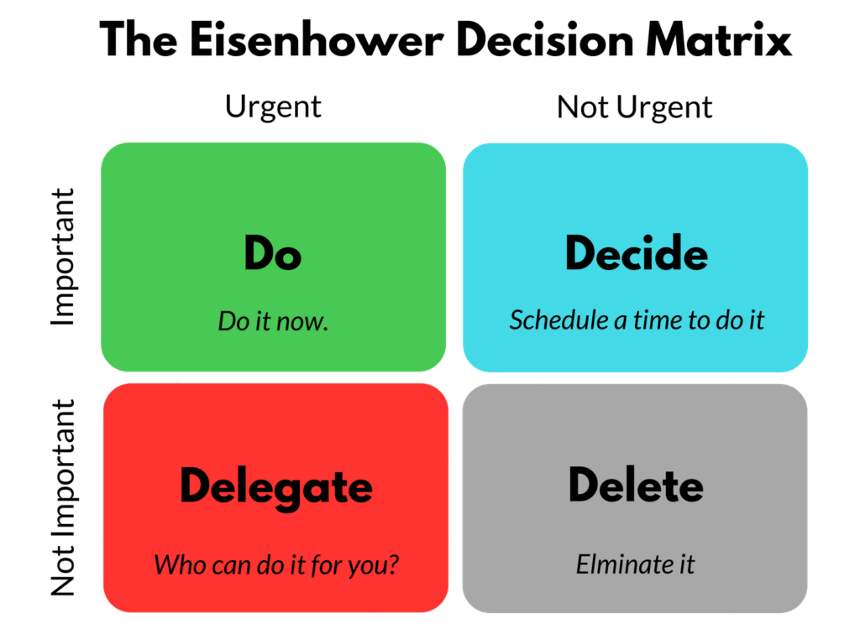“Time is like money. Without being managed properly, how do you know where it’s going?”
Benjamin Franklin
Time management is not a single stand-alone subject or theory. It is related to a lot of other subjects like productivity, work-life balance, avoiding burnout, focused work, building good habits, and setting goals. This post is focused on the best practices in scheduling, prioritizing, and effective time management strategies that we’ve learned from super successful people.
Table of Contents
ToggleWhat is time management?
Time management is the process of planning and dividing tasks to increase efficiency or productivity.
Why is time management important?
Time management is the key to lead to success. If you want to be a world-class leader and have a good life and work balance and generally want to be successful in your career and in your life, you need to pay a lot of attention to this factor. If you are a manager, you have to finish your work as well as you are responsible for your teamwork. In that case, you need to have smart time management strategies. A good read by teamdeck.io for smart time management strategies.
Through time management you can keep a track of all your work, which helps to reduce your stress level and get more out of the day.
Good time management teaches you to be a self-reliant, and self- disciplined which are the two basic pillars of life. It helps you to focus and leads to more career success.
The most advantageous thing about time management is that you will get some free time to learn about new things or anything that you are passionate about. This will take you closer to your goals. Or if you want you could give yourself that free time and just relax!
“Time is precious because eternity hinges on how we spend it” -Jonathan Edwards

21 Time management strategies to skyrocket your productivity
Understand how you are spending your time
- Discover your own “WHY” to effectively manage your time and life
- Be realistic about your goals and actions
- Track which activities you are wasting your time
- Set daily goals and track the results
- Create a morning ritual that gives you energy and focus rest of the day
Prioritize your priorities
- Understand the difference between the important and urgent
- Prioritize, Prioritize, Prioritize…if you can’t prioritize something, delegate it or better abandon it. (it doesn’t worth your time and focus)
- Learn to say “NO”.
- Create a daily to-do list and set priorities for each task. To-Do-List is motivating because it gives a clear idea of what is to be accomplished each day. — ProofHub
- Don’t multitask. It reduces your focus drastically.
- Schedule breaks in between (at logical break). This gives you fresh energy to take up the next task enthusiastically. Set up an efficient daily schedule
Set up an efficient daily schedule
- Set schedules and deadlines (Sometimes deadlines work very well to get the things done on time) and have an eye on time tracking.
- Create Yearly, Half Yearly, Monthly, Weekly, and Daily Plans
- Be clear about the goals you want to achieve at the end of each period
- Spend some time to plan your week on Sunday
- Before going to sleep review, your day and plan the next day
- Group similar activities together
- Use the Pomodoro Technique to focus on the task at your hand
- set aside a time to answer your emails. No one is expecting you to answer immediately.
- Allocate some time for project management activities, where you will be allocating specific tasks to our team members.
- Allocate time for your phone calls. If you are in the middle of some important task, you can let this call go missed. Once you finish your important work, then you can call back.
These are the time management tips that work.
Time management requires practice and successful people find better ways to control and use their time. They understand that everyone has got 24 hours in a day but those who will be managing their daily task and important tasks effectively only can see success.
Eisenhower’s Urgent-Important Matrix

Eisenhower’s Urgent-Important Matrix, also known as the Eisenhower Box, is a time management tool that helps prioritize tasks based on their urgency and importance. The matrix is divided into four quadrants:
- Urgent and Important (Quadrant I): These tasks require immediate attention and are critical for your success. Examples include pressing problems, deadlines, and crises.
- Important but Not Urgent (Quadrant II): These tasks are important for long-term success and personal fulfillment but do not have immediate deadlines. Examples include planning, relationship building, and personal growth activities.
- Urgent but Not Important (Quadrant III): These tasks demand immediate attention but are not necessarily important for achieving your long-term goals. Examples include some emails, calls, and interruptions from others.
- Not Urgent and Not Important (Quadrant IV): These activities are neither urgent nor important and can be considered distractions or time-wasters. Examples include trivial tasks, excessive entertainment, and spam emails.
The key to effective time management using the Eisenhower Matrix is to spend more time in Quadrant II, focusing on activities that are important but not urgent. This approach helps in reducing crises and stress while ensuring progress towards long-term goals and personal development.
By categorizing tasks into these quadrants, individuals can make better decisions about where to focus their energy and resources, leading to increased productivity and effectiveness.

Pomodoro time management technique
The Pomodoro Technique is a time management method developed by Francesco Cirillo in the late 1980s. It’s named after the tomato-shaped kitchen timer that Cirillo used as a university student (pomodoro is Italian for tomato). The technique involves breaking work into intervals, traditionally 25 minutes in length, separated by short breaks. Here’s how it works:
- Choose a Task: Select a task you want to work on.
- Set a Timer: Traditionally, set the timer for 25 minutes. This period is known as a “Pomodoro.”
- Work on the Task: Work on the task until the timer rings. If a distraction pops up, write it down and get back to work immediately.
- Take a Short Break: Once the Pomodoro rings, take a 5-minute break. This helps to refresh your mind and prepare it for the next session.
- Repeat: After four Pomodoro sessions, take a longer break, around 15-30 minutes.
The goal of the Pomodoro Technique is to instill a sense of urgency. Rather than feeling like you have endless time in the workday to get things done and then ultimately falling prey to distraction, you know you only have 25 minutes to make as much progress on a task as possible. Additionally, the regular breaks keep the mind fresh and focused.
This technique can help improve concentration and attention span, reduce anxiety over time constraints, and increase productivity by forcing you to work with the time you have rather than against it.
Time management strategies to improve your productivity in the workplace | Time management strategies for professionals
Here are some time management strategies that can improve productivity in the workplace, specifically tailored for professionals:
- Set Specific Goals: Establish clear, measurable objectives that align with your professional priorities. This helps focus your efforts on what truly matters and makes it easier to track progress.
- Prioritize Tasks: Use the Eisenhower Box or a similar method to categorize tasks by their importance and urgency. Focus on high-priority activities that have the greatest impact on your goals.
- Plan Your Day: Allocate specific time slots for different tasks, including checking emails, meetings, and core work activities. This can help minimize distractions and ensure that key tasks are not overlooked.
- Minimize Distractions: Identify common distractions in your work environment and take proactive steps to reduce them, such as turning off unnecessary notifications or scheduling specific times to check emails.
- Delegate Effectively: Understand which tasks can be delegated and assign them to appropriate team members. This not only lightens your workload but also helps in developing others’ skills.
- Use Time Management Tools: Leverage technology by using apps and software for scheduling, task management, and setting reminders. Tools like Trello, Asana, or Google Calendar can help keep you organized and on track.
- Take Regular Breaks: Short breaks throughout the day can improve mental clarity and prevent burnout. Techniques like the Pomodoro Technique encourage working in bursts followed by a short break.
- Learn to Say No: Politely decline requests or commitments that do not align with your priorities or would overload your schedule, preserving your time for important tasks.
- Continuous Improvement: Regularly review your time management practices and identify areas for improvement. Staying adaptable and open to new techniques can enhance your productivity over time.
Implementing these strategies can help professionals manage their time more effectively, leading to increased productivity and a better work-life balance.
Time Management Tips for Students
Here are some time management tips for students:
- Create a Schedule: Use a planner or digital calendar to map out your class times, study sessions, and extracurricular activities. Seeing your schedule visually can help you understand how to allocate your time effectively.
- Prioritize Tasks: Identify which assignments and studies are most urgent and important. Focus on completing these tasks first to ensure you meet deadlines and prepare for exams.
- Break Down Big Tasks: Large projects can be overwhelming. Break them into smaller, manageable parts and set deadlines for each segment to make progress steadily without stress.
- Avoid Procrastination: Set clear goals for each study session and use techniques like the Pomodoro Technique (25 minutes of focused work followed by a 5-minute break) to maintain concentration and avoid burnout. Suggested Read: How delaying task harm your health
- Set Specific Goals for Study Sessions: Before you start studying, decide what you want to achieve in that session. Having a clear goal helps to keep your study sessions productive.
- Use Downtime Wisely: Short periods between classes or activities can be used for quick study sessions or to review notes, helping to reinforce learning and reduce last-minute cramming.
- Limit Distractions: Identify what distracts you (e.g., social media, phone calls) and minimize these distractions during study time. This might mean turning off your phone or using apps that block distracting websites.
- Get Enough Sleep: Adequate rest is crucial for memory retention and focus. Ensure you get a good night’s sleep, especially before exams or important meetings.
- Practice Self-care: Regular physical activity, healthy eating, and time for relaxation are important for maintaining energy levels and focus.
- Review and Adjust Your Schedule Regularly: As your priorities and deadlines change, take time to adjust your schedule. Regularly reviewing and updating your plan can help you stay on track and adapt to new responsibilities.
By implementing these time management tips, students can improve their ability to focus, reduce stress, and achieve academic success more effectively.
Suggested Read: Time Management Strategies for teenagers
Frequently Asked Questions(FAQs) on Time Management
Is time management needed if I am passionate about something?
Some people are lucky to have found a career that includes their passion, whereas others are still struggling to make time for it.
Sometimes your work and responsibilities take a huge chunk of your life which makes it difficult for you to take a little time out for yourself. But if you are really passionate about something you will anyhow manage to keep it on track. You might skip your meal while doing that as the joy fills up your stomach, or skip plans with friends or family.
But how do we do what we love without skipping plans and keeping the whole thing in balance?
Only through time management techniques, you can know how to manage time wisely, and also you will get an idea to sustainably use the time to create what really matters to you. Time management is a tool to improve the quality of your life. To progress with life, learning to manage time and spend it astutely, is the most important thing to do.
What are the problems faced if we lack time management?
- Poor time management results in procrastination.
- Postponing work for the last-minute leads to stress as the work overloads your head.
- Urgent assignments,
- late working hours,
- unclear expectations,
- build up a hostile space inside your head that ultimately results in impatience.
Lack of time management may induce fear into a person. Supposedly, you gave a commitment to your boss and you are failing to meet the deadline. The fear of not being able to complete before the deadline; the fear of missing commitments develops low self-esteem.
As we all know time is limited, if not well used cannot be retrieved. Most of the time, people complain about a lack of time when they cannot complete their work or maintain their usual routine on time thus resulting in dissatisfaction with your own output or productivity. Therefore, one bad habit of ineffective time management leads one problem to another problem.
How can we improve your productivity with time management?
Improving productivity with time management involves prioritizing tasks, setting clear goals, and allocating specific time blocks for each task. By minimizing distractions and focusing on one task at a time, you can complete tasks more efficiently and effectively.
What are the 4 P’s of time management?
The 4 P’s of time management are Planning, Prioritizing, Protecting, and Performing. Planning involves mapping out tasks and deadlines, Prioritizing means determining the order of tasks based on importance, Protecting refers to guarding your time from distractions, and Performing is the actual execution of tasks.
What are the 4 types of time management?
The 4 types of time management are often referred to as different approaches or styles, such as the quadrant method (urgent vs. important), the ABC method (categorizing tasks), the Pareto analysis (80/20 rule), and the Eisenhower box (urgent-important matrix).
What is the best strategy for managing time?
The best strategy varies per individual, but a common and effective approach is the Eisenhower Box, which helps prioritize tasks by urgency and importance, enabling individuals to focus on what truly matters.
Why is time management important for productivity? | How does time management affect productivity?
Time management is crucial for productivity because it helps individuals allocate resources efficiently, reduce stress by preventing last-minute rushes, and achieve goals within set deadlines, thereby increasing overall output and satisfaction.
How does time management improve the quality of work?
Effective time management allows for better planning, focus, and execution of tasks, leading to higher quality work. It reduces the need for multitasking and rushing, which can lead to errors and lower quality outcomes.
What is the best way to manage your time effectively?
The best way to manage time effectively is to set clear goals, prioritize tasks, avoid procrastination, and review your time management plan regularly to adjust for improvements or unexpected changes.
Read: Other Informative Blogs
Some sections of the text within this article may have been generated using AI tools and then revised by the author to enhance the overall quality and clarity of the content for readers.

